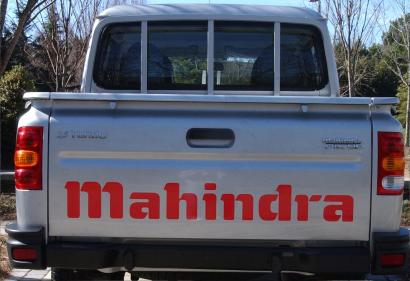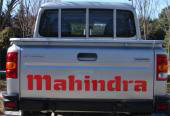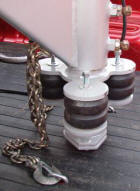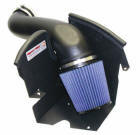The Atlanta Journal-Constitution
Published on: 02/04/07
Coming soon to a car dealer near you — Indian SUVs.
Say what?
|
Kimberly Smith/AJC
|
| Mahindra & Mahindra has a yet-unnamed-for-the-U.S. market five-passenger, four-door vehicle with a pickup bed. In 2005, the firm was No. 34 on Automotive News' list of worldwide manufacturers. |
India is the latest Asian tiger ready to leap into the world's most lucrative auto arena. By 2009, Americans hunting for automotive bargains might find Mahindra & Mahindra's utility vehicles alongside Fords and Chevys. Global Vehicles USA Inc., an Alpharetta auto importer and distributor, holds the exclusive right to sell the Indian SUVs, crossovers and pickup trucks to dealers across the country. Allan Vigil will make room on his Morrow lot for the six-speed, diesel-burning, four-wheel-drive vehicles.
"The Indians are coming and why not? Hell, everybody else is here," Vigil, Georgia's largest Ford dealer, said last week. "I've been a Ford guy for 30 years and this is the first time I'll bring anything in other than Ford products."
As if the U.S. auto industry didn't have enough problems.
Buffeted by Japanese and Korean competition, U.S. carmakers hemorrhage red ink like stuck pigs. Ford lost $12.7 billion last year.
 Mahindra, which has already captured one-fourth of
the U.S. tractor market, is taking a page from its North
Asian brethren by offering snazzy vehicles at decent
prices (about $25,000 for an SUV) with good mileage
(35-39 mpg).
Mahindra, which has already captured one-fourth of
the U.S. tractor market, is taking a page from its North
Asian brethren by offering snazzy vehicles at decent
prices (about $25,000 for an SUV) with good mileage
(35-39 mpg).
In the process, India lets the world know there's another player on the global block.
"Indian companies are going abroad and doing pretty well," said Ash Thakker, chairman of the Georgia Indo-American Chamber of Commerce. "They can stand on their own against international competition."
Romanian debacle
India wasn't John Perez's first foreign auto partner. Beginning in 1994, Perez, the CEO of Global Vehicles, tried to import a Romanian SUV, known as the Cross Lander. He'd bought the Romanian factory from the government, shipped 2,000 of the bare-bones utility vehicles to Latin America and signed up 148 U.S. dealers. He'd even convinced Washington to temporarily waive stringent air-bag regulations. He pulled the plug in 2005, mired in lawsuits with the Romanian government and complaining of "huge corruption."
"Their government," Perez, a fierce anti-Communist born in Cuba, said last year, "is not ready for the world of business as we know it in America."
India, apparently, is.
Mahindra contacted Perez during his Romanian affair. The Mumbai-based conglomerate, one of India's biggest corporations, is the world's fourth-largest tractor maker and runs a factory in Calhoun.
Mahindra began making Jeep-like vehicles, known as Willys, in 1954. Its durable off-road vehicles are popular with India's farmers and soldiers.
Mahindra sold only 127,521 vehicles in 2005 to rank 34th on Automotive News' list of manufacturers. Like Honda, Toyota, Hyundai and Kia, though, the company decided the future lay overseas.
It sells SUVs jointly with auto dealers in South Africa, Europe and Australia. A factory in Uruguay also churns out Scorpios, its most popular utility vehicle. Others are planned for Egypt and Russia. French automaker Renault will also co-produce 500,000 vehicles a year with Mahindra in India.
The United States, where 2.27 million SUVs were sold last year, is the world's utility vehicle leader. But it's a tough time to crack the lucrative market. Already, 45 companies peddle SUVs here. Sales are expected to drop to 2.18 million this year, according to J.D. Power and Associates.
"Does the U.S. market need another SUV?" asked James D. Power IV, executive vice president for international operations with the research and marketing company of the same name. "If you're a dealer or a manufacturer, do you have the stamina to play in that game?"
Mahindra says it does.
"It will be a long process," Sanjeev Mohoni, the company's vice president for overseas operations, said last week from Mumbai. "But we believe we offer a very good SUV and 4-by-4 for very attractive prices, and that's what we're going to build on."
Big plans
High gas prices and pollution have caused America's love affair with SUVs to wane. Perez says a cheaper, more energy-efficient SUV will rekindle this country's passion for big vehicles.
So far, 205 dealers east of the Mississippi agree. Negotiations are under way with the Georgia Ports Authority to bring 40,000 of Mahindra's SUVs, crossovers and pickup trucks through Brunswick to be ready for sale in late 2008. Perez expects to sell 100,000 of the vehicles by 2011. By then, he hopes 300 dealers will make room on their lots for the Indians.
Global vehicle revenue, pegged at $400 million the first year, should nearly quadruple by 2011. The company hopes to quintuple its 24-member work force by then, too.
Global is scouring the Alpharetta region for an auto parts distribution warehouse. Perez says "it's a very good possibility, depending on demand" that Mahindra will build an assembly plant in the United States. South Carolina's governor has already alerted him to possible sites, he says, adding that he hopes to meet with Georgia Gov. Sonny Perdue this week.
"This could happen very quickly," Perez added.
Industry experts, though, dismiss the hype. Mahindra must first overcome the perception, held by many Americans, that India remains a backward country where quality takes a back seat to frugality.
India's per-capita GDP, after all, is less than one-tenth the U.S. average ($43,500). The United Nations ranks India No. 126 (out of 196 countries) on its "human development index."
"There's an emotional element in purchasing a car. And in selling a car, image is huge," said Bernard Swiecki, senior project manager for the Center for Automotive Research, a not-for-profit think tank in Michigan. "Value isn't enough. You never overcome a reluctance in the market with just cheap prices. The vehicle itself has to meet expectations."
Perez recently displayed the Mahindras outside his Alpharetta office.
•A 2006 Scorpio SUV, on sale in Europe, Australia and South Africa, with room for seven people and a stylish diesel air scoop on its hood. Leather seats. CD player. Six-speed automatic transmission. Price: mid-$20,000 range.
•A four-door, deep-bedded, sport recreation vehicle "designed for the younger generation," according to Perez. Price: a couple thousand dollars less than the SUV. Perez, like industry experts, predicts budget-conscious consumers will replace SUVs with SRVs.
•A long-bed, two-door pickup truck. Price: $21,000-22,000.
All of the vehicles will be four-wheel drive, turbo-charged with "clean diesel" technology and get up to 39 miles per gallon.
"That's the biggest thing we're selling," Perez said. Already popular in Europe, diesel vehicles are expected to make up 10 percent of sales by 2015, according to J.D. Power, triple today's numbers. Power himself labels Mahindra's all-diesel push "an innovative approach." The company awaits U.S. government approval for its diesel engine.
Targeting Indians
A niche product, Mahindra plans to sell only 100,000 vehicles a year in the United States within three years. Ford, by comparison, sold nearly 3 million vehicles last year.
But Global Vehicles, with an initial $40 million marketing budget, will also target consumers not typically singled out by national ad campaigns: the growing, educated, increasingly wealthy Indian-American population. Nearly 80,000 Indians live in Georgia, according to the U.S. Census Bureau. Thakker estimates they own 8,000 businesses, including hotels, gas stations, convenience stores, medical and engineering firms.
"I live in Eagle's Landing and I see a lot of Indians, and they're driving mostly foreign cars," said Vigil, who paid Global $125,000 for a Mahindra franchise. "They may be very loyal to a brand made in their own country."
Quality and price, not nationalism, will more likely influence Indian-American consumers, Thakker says.
India's growing prominence in manufacturing and technology should, tangentially, help boost SUV sales. India's economy grew 8.5 percent last year. Total U.S.-India trade has jumped nearly a third the last few years to $17 billion. Displaced U.S. workers are familiar with India's low-wage, high-quality information-technology sector. The country's steel, auto parts and textile industries zoom. The Georgia Department of Economic Development may open a trade office in India by 2009.
"We have started making a name for ourselves in technological areas so people are aware of Indian industry and expertise," said Mohoni. "We will try to build on that."
|
|








